Economic activity of the population - 3. quarter of 2007
02.11.2007
Code: e-3133-07
Economic activity of the population in the third quarter of 2007
Employment in the primary sector (agriculture, forestry, fishing) decreased by 11.3 thousand to 177.3 thousand persons year-on-year and made up only 3.6% of the total number of first (main) jobholders. The number of persons employed in the secondary sector (industry, construction) increased compared to Q3 2006 by 49.5 thousand to 1 984.7 thousand (40.2% of total employment). This growth was mainly affected by the year-on-year increase of 44.8 thousand in employment that occurred in ‘manufacturing’. The number of employed persons went up most in ‘manufacture of electrical equipment n.e.c.’ (+8.7 thousand), ‘manufacture of motor vehicles’ (+8.0 thousand), ‘treatment and coating of metals; general mechanical engineering’ (+7.2 thousand), ‘manufacture of plastic products’ (+6.8 thousand) and ‘manufacture of insulated wire and cable’ (+6.6 thousand). Decrease in the number of employed in ‘electricity, gas and water supply’ by 7.2 thousand showed itself most in ‘steam and hot water supply’. 1 )
Employment in the tertiary sector (all divisions of services including transport) increased by 64.7 thousand to 2 779.7 thousand (56.2% of total employment), but it developed in the individual divisions in an opposing way. Employment increased most in ‘real estate; renting and business activities’ (+40.0 thousand), ‘financial intermediation’ (+12.9 thousand), ‘education’ (+7.9 thousand) and ‘health and social work’ (+6.8 thousand).
Within the section ‘real estate; renting and business activities’ the growth was especially in the groups ‘legal, accounting, book-keeping and auditing activities; tax consultancy; market research and public opinion polling; business and management consultancy; holdings’ (+10.1 thousand), ‘software consultancy and supply’ (+7.2 thousand) and ‘investigation and security activities’. In ‘financial intermediation’ employment grew the most in ‘insurance and pension funding, except compulsory social security’. Within the section ‘education’ the number of employed persons increased mainly in ‘adult and other education’ and ‘secondary education’. In ‘health and social work’ employment increased the most in ‘social work activities’ and ‘human health activities’. The number of employed in ‘general (overall) public service activities’ however dropped year-on-year. In this context it is necessary to mention that differences compared to enterprise statistics result, apart from other things, from the fact that the concept of employees in the sample survey has a more general character and does not directly apply to so-called registered number of employees.
On the other hand, employment dropped most year-on-year in ‘hotels and restaurants’ (-5.9 thousand), the most in ‘restaurants’. Employment decrease in ‘public administration and defence; compulsory social security’ was due to lower employment in ‘provision of services to the community as a whole’.
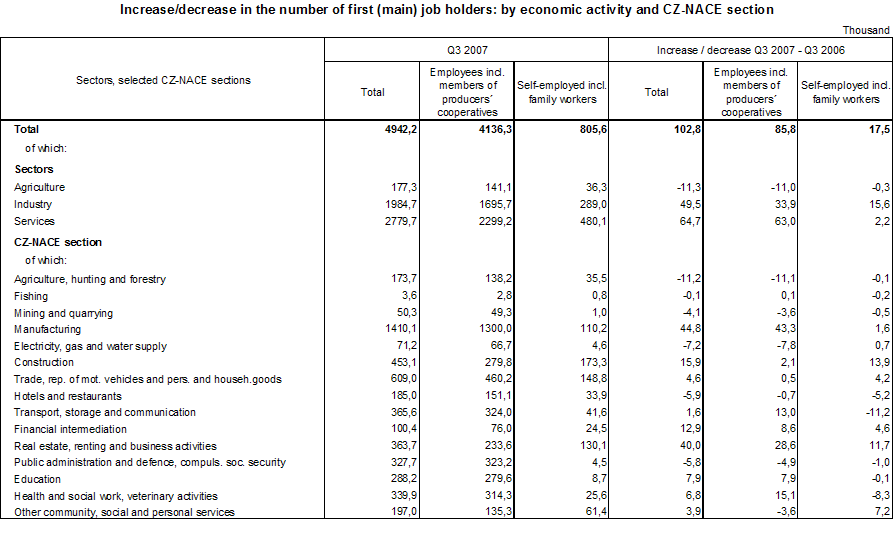
An increase in the total number of self-employed by 17.5 thousand showed itself mainly in the sections ‘construction’ (+13.9 thousand) and ‘real estate, renting and business activities’ (+11.7 thousand). Year-on-year increase in the number of self-employed persons, including contributing family workers was the highest in ‘building completion’ and ‘building installation’. In the section ‘real estate, renting and business activities’ increase resulted from a higher number of self-employed in ‘legal, accounting, book-keeping and auditing activities; tax consultancy; market research and public opinion polling; business and management consultancy; holdings’ and in ‘real estate activities on a fee or contract basis’. The number of self-employed increased markedly also in ‘other community, social and personal service activities’ and in ‘other retail sale of new goods in specialised stores’.
The total employment rate among persons aged 15-64 grew year-on-year by 0.9 percentage points to 66.3%. The relative increase was higher in the employment of men at working age (+1.3 percentage points to 75.2%), while employment of women was 0.5 percentage points up and reached 57.3%. The employment rate is pushed down by a fast growth of the number of students at universities on the one hand, and, on the other hand, the number of persons in job is increasing due to the concurrence of employment of strong age groups born around 1950 and the mid 1970’s.
Concrete aims for the employment rate in the EU countries until 2010 were determined in the meetings of the European Council in Lisbon in 2000 and Stockholm in 2001. The total employment rate should reach at least 70%, employment rate of women at least 60% and the employment rate of the elderly aged 55-64 at least 50%.
Compared internationally, the Czech Republic is among the countries with the above-the-average employment intensity in the EU. According to the latest complete data for Q1 2007 released by Eurostat, the employment rate of persons aged 15-64 in the Czech Republic was higher than the total for the EU27 but lower than the rate in the EU15. Lower employment rate than in EU15 and EU27 was in the group of women.
Differences in employment rates between EU countries are considerable, not only if we compare the whole age group 15-64, but also in the male and female components of employment. On the one hand, there is a high level of employment in the northern countries and the United Kingdom (e.g. in Denmark it was 76.7% in Q1 2007), on the other hand in many countries the level of employment was lower than 60% (in Poland only 55.4% in Q1 2007). Compared to our neighbour states, higher level of employment is in Austria and also in Germany, level of employment in Poland and also in Slovakia is, however, significantly lower. Very low unemployment rate is also in Hungary.
Even bigger differences are in the employment level of persons aged 55-64. In Malta and Poland it did not even reach 30% and this level was only closely exceeded by Slovenia, Slovakia, Italy, Hungary and Belgium. Thus a significant number of member states will have problems with the fulfilment of the Lisbon strategy. In the Czech Republic, the reaching of at least 50% employment rate in this ten-year age group is going to be also complicated, mainly due to the low employment rate of women. The employment rate of women aged 55-64 is lower than not only the average of the EU15 but also the EU27. It is, however, possible to assume that in the following years this rate is going to rise also as a consequence of setting of the conditions for getting old-age pension.
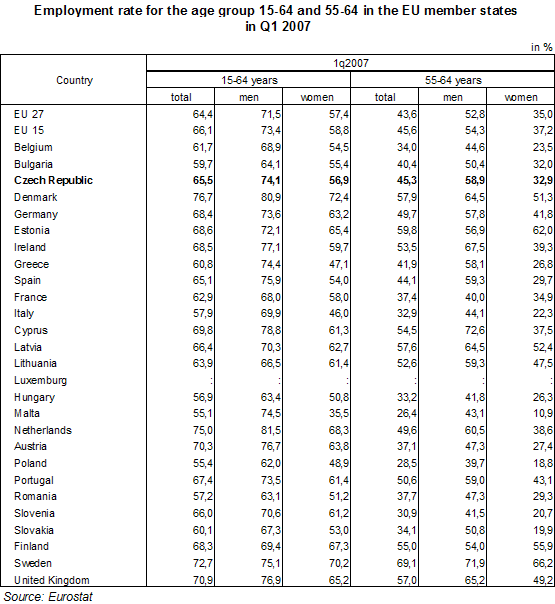
For the CR’s economy a high share of secondary sector (industry + construction) employment is typical. This share is the highest among all of the EU27 countries and close to the Czech Republic is only Slovakia. Similarly, in ‘manufacturing’ the share reached 28.7% of total employment in the CR in Q1 2007. This was the highest figure among all EU states. In the CR, ‘manufacturing’ had by 10 p.p. higher share in total employment than it had in the EU27 and by over 11 p.p. higher than in the EU15. On the other hand, our branch structure of employment is distinguished by a significantly lower proportion of services than in the EU15 (-14 p.p.), but also in the EU27 (-10 p.p.). In the CR, lower than average employment proportion is mainly in ‘real estate, renting and business activities’, ‘health and social work’, ‘financial intermediation’ and ‘education’. In the following table, there are data on the branch structure of selected EU states in Q1 2007, for which Eurostat published the latest complete results.
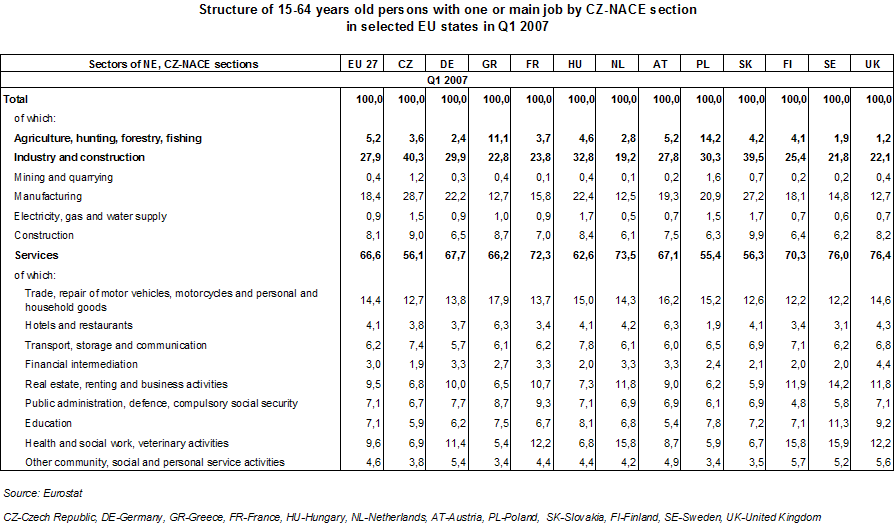
The employment of persons living in the individual regions of the Czech Republic dropped slightly in the Ústecký and Liberecký Region year-on-year. The number of employed persons on the other hand increased the most in the Moravskoslezský, Jihomoravský and Hl. m. Praha Region. A marked increase was recorded in the Středočeský Region, the highest relative increase in the Jihočeský Region.
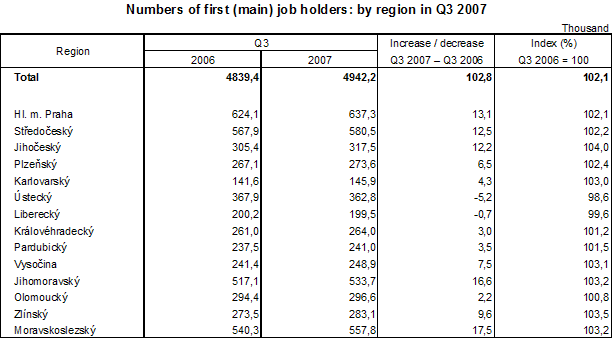
There were 94.8% of persons working full time in their main job in the civil sector of the national economy. Nearly 241.2 thousand persons worked part-time in their main job, most of them were women (176.0 thousand).
The share of persons working full time in their main job is in the CR the fourth highest among all EU27 member states. Proportion of full time jobs is higher in Slovakia, Hungary and Bulgaria, the total employment rate is however below the average in all of the three countries. The share of men working full time in the CR was the third highest among the EU27 countries in Q1 2007, women had the fifth highest share.
Especially women appear to have an extraordinary high differentiation of the shares of full time jobs in employment in individual EU countries. In several countries of the EU15, high number of women uses the opportunity to work part time, particularly in the Netherlands (3/4 of working women aged 15-64 years!) and in the other five countries their share came close or exceeded 40% of women employment. The opportunity to work part time is one of the social aspects, which in the long term affects the fertility rate in particular in the Netherlands and in some of the other countries.
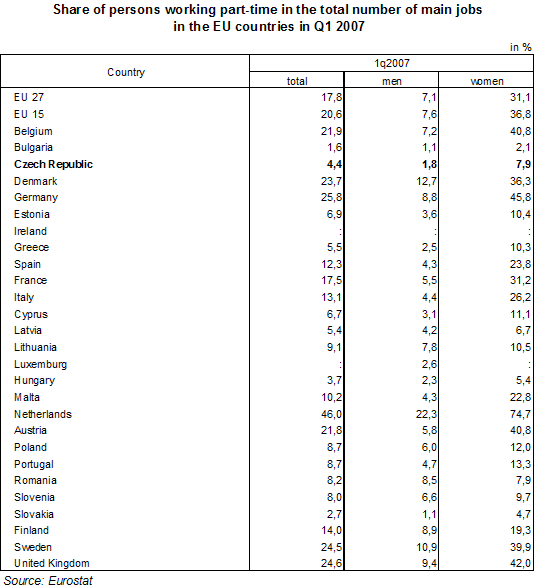
The number of hours actually worked in the reference week reached 35.6 hours, in full-time employment it was 36.4 hours. The differences in working hours of employees are large, both in terms of their professional status and industry (CZ-NACE sections). The self-employed worked approximately 45.4 hours a week, members of producer cooperatives 39.7 hours and full-time employees 34.7 hours. In the long term, these differences are apparent both for men and women when generally men work longer in all of the status categories. The most hours worked in their main job had employees in construction (41.8 hours), the least had employees in education (21.2 hours). Hours worked figures in Q3 are always largely affected by seasonal variations (holidays).
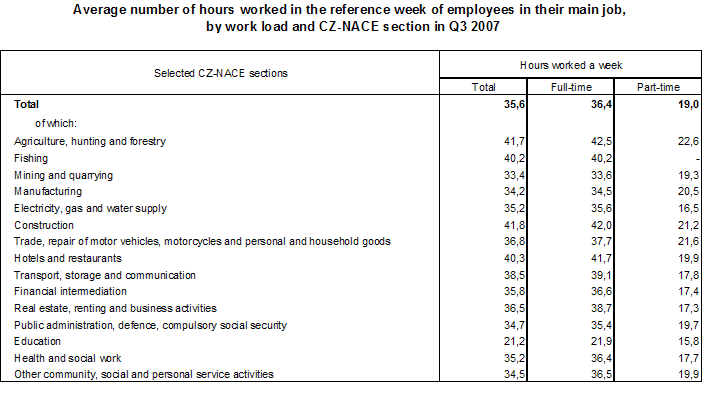
With the growing total employment of the residing population and the economically inactive, the number of the unemployed decreased. The number of unemployed persons (ILO methodology) reached 266.7 thousand on average in Q3 2007, i.e. a fall of 98.3 thousand year-on-year (more than a quarter). The number of the unemployed decreased the most in the age group 20-24 (by 27.8 thousand); and in the age group 40-44 (by 12.1 thousand). The number of unemployed men (119.7 thousand in total) is still below the number of unemployed women (146.9 thousand). Under the total year-on-year drop in unemployment, the unemployment of men decreased by 44.7 thousand, and the decrease showed itself in the whole group of 15-59 years old persons. Over the same period, the number of unemployed women decreased by 53.7 thousand in total; it dropped in all of the other five-year groups of the working age, except the oldest age group 55-59.
The number of the long-term unemployed (1 year or more) fell by 62.3 thousand in total, this drop showed itself in all of the age groups of both men and women below 60 years.
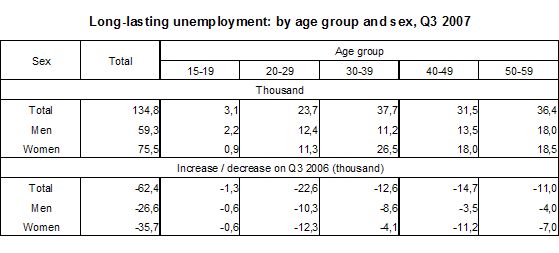
The number of the unemployed with basic education decreased by 18.6% year-on-year to 69.0 thousand, which is connected with a general decrease of the number of Czech citizens at working age with the lowest level of education. The number of unemployed persons with secondary education without maturita examination (secondary vocational school graduates in particular) decreased by 26.9% to 120.7 thousand and the number of the unemployed with secondary education with maturita examination decreased by 34.0% to 61.4 thousand. The number of unemployed university graduates dropped by 30.0% to 15.4 thousand; the unemployment of university graduates is still markedly lower when compared to the first three groups.
Year-on-year, the unemployment dropped in all of the regions of the country except the Vysočina Region, the most in areas with high or above the average unemployment rate i.e. in the Moravskoslezský and Ústecký Region and further in the Jihomoravský Region.
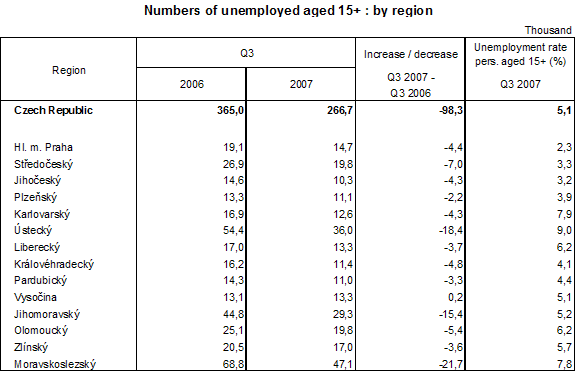
The growth of total employment and the decrease in the number of the unemployed resulted in a relatively high decrease of general unemployment rate of persons aged 15-64 (ILO). In comparison to Q3 2006, the general unemployment rate decreased by 1.9 percentage points to 5.2%. It decreased mainly among the female population (by 2.3 percentage points to 6.5%), while it dropped among the male population by 1.6 percentage points to 4.1%. According to the latest data released by Eurostat for Q1 2007 the general unemployment rate in the Czech Republic was markedly lower than in the EU27, when besides the relatively low unemployment level of men also the level of unemployment of women in the CR was below the average of the EU27. The big decrease of unemployment in the Czech Republic resulted in favourable comparison with the EU27 and the EU15 alike when in Q1 2007 the unemployment rate in the CR was lower than the average of the EU15 by 1.5 percentage points.
In comparison to the neighbour states, the level of unemployment in the CR is higher than in Austria but markedly lower than in Slovakia and Poland where it is still the highest across the European Union. Unemployment level in the CR is noticeably lower also in comparison with Germany mainly due to an unfavourable situation in the long run in the federal states of former East Germany.
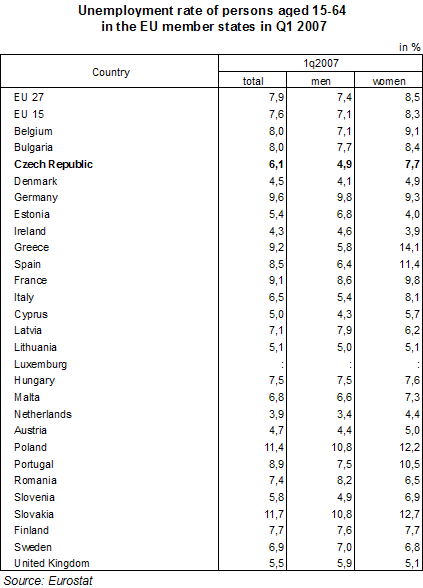
According to the latest Eurostat estimate for September 2007, the seasonally adjusted unemployment rate dropped by 1.0 p.p. to 7.0% in the EU27 compared to September 2006. The general unemployment rate decreased in 23 countries year-on-year, the most in our neighbours Poland and Slovakia, and in Lithuania.
The number of economically inactive persons aged 15+ (according to the LFSS methodology they are persons who had no job and were not seeking a job during last four weeks or did not meet all conditions for being classified among the unemployed) increased by 70.9 thousand year-on-year and reached 3 644.6 thousand in Q3 2007. This category is primarily affected by numbers of the retired and of persons in schooling or training for their future occupation. The number of basic school pupils decreased by 2.3 thousand; the number of secondary school pupils including vocational school pupils decreased by 1.9 thousand to 524.5 thousand. The number of university students including higher professional school students grew by 22.9 thousand to 292.0 thousand. The number of economically inactive normally retired persons not actively seeking job reached 1 920.9 thousand, the number of persons in early retirement 45.6 thousand and the number of disability pensioners 248.8 thousand. These figures cannot accurately correspond to the numbers of pupils and students according to the statistics of the Ministry of Education, Youth and Sports of the CR or to the numbers of pensioners on the records of the Ministry of Labour and Social Affairs of the CR because the pupils, students or pensioners who fulfilled the criterion of being classified among persons in employment or unemployed persons in the reference week are not recorded as economically inactive.
_________________
1) Note: When evaluating the branch structure of the employed it is necessary to take into consideration the methodology of sample survey, which is carried out only in flats and not in collective accommodation establishments. Data on the number of employed from LFSS is then corrected by statistics within the harmonization with data on employment development of foreign nationals in the branch. According to the available data from the Ministry of Labour and Social Affairs of the CR and the Ministry of Industry and Trade of the CR there is a marked increase of the number of foreign nationals in manufacturing, construction, trade and real estate, renting and business activities, who mostly do not live in flats.
Published: 02.11.2007
The data are valid as of the release date of the publication.
Contact: Information Services Unit - Headquarters, tel.: +420 274 056 789, email: infoservis@czso.cz










